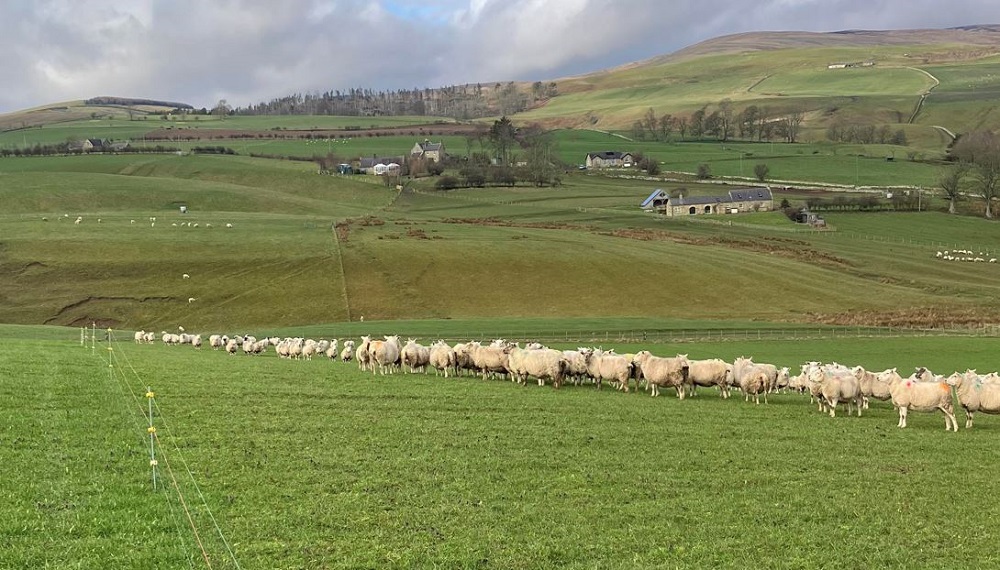Trialling a pre-lambing rotation at Alnham Farm (case study)
Thursday, 27 April 2023
Rhidian Jones (RJ Livestock Systems Ltd) explores the principles that underpin a pre-lambing rotation (PLR) and their application at Alnham Farm (an AHDB Monitor Farm in Northumberland).
Visit the Northumberland Monitor Farm home page
What is a pre-lambing rotation?
In a grass lambing flock, where ewes are set stocked for lambing, a pre-lambing rotation (PLR) is sometimes carried out to reset the pasture and promote tillering and grass growth.
This is done for 14–21 days before set stocking if average farm covers on the grazing platform exceed 1,700 kg DM/ha.
PLR principles
It is important not to graze the sward to below 1,400 kg DM/ha or 4–5 cm. Leaving this residual ensures that there is still leaf area for photosynthesis as day length increases.
Paddocks should only be grazed for one day to ensure that the residual is not exceeded, giving an even spread of nutrients from dung and urine.
The nutritional requirements of the ewes must also be met, so the area to give the ewes each day must be carefully calculated.
If the grass supply is tight, then it may be best kept until after lambing and supplements fed instead. This is an individual decision for each farm and season.
PLR at Alnham Farm (case study)
This year, Alnham Farm trialled a PLR for 21 days from 2–22 March 2023, with 180 twin-bearing ewes of 70 kg in body condition score (BCS) 3.0.
BCS is important to the success of the PLR and subsequent lambing.
Twenty-one hectares (including 16 ha of a multi-species sward) were split into 1 ha paddocks using electric fencing.
Grass covers averaged 1,700 kg DM/ha at the start, having been rested since November 2022.
The farm budgeted for 2.5% of bodyweight or 1.75 kg DM/hd/day. This gave 315 kg DM/day for the group, providing the ewes 19MJ ME/hd/day (assuming pasture ME of 11).
Ewes were moved daily; thus, 315 kg DM/ha removed – ewes are unlikely to consume more than this, so it ensures that the sward is not grazed below the desired residual.
PLR progress
- A week into the PLR, there was cold weather and snow, so two high-energy blocks were put out. The snow was not excessive and did not deter the ewes from grazing. However, grass growth did slow in this period, and soil temperatures fell from 7oC to 4oC
- On 23 March, the ewes were set stocked in 4 fields for lambing at 2½ ewes/acre
- Grass covers on these fields averaged 1,650 kg DM/ha
- Glucose buckets were also put out
- Lambs averaged 4.5 kg birthweight; ewes have had plenty of colostrum, and the lambs have got away to a good start, an essential requirement to improved lamb growth rates
- The four groups will be ‘mobbed up’ into one group post-marking and will then be rotationally grazed on multi-species swards from 1 May
- No compound feed or supplementary forage has been fed since the end of February
- The savings in concentrates alone will amount to £8–10/ewe (compared to previous feeding practices)
“The pre-lambing rotation has stimulated grass growth, and we have saved money this year as these ewes have had no concentrate feeding”
Harry Sordy, AHDB Monitor Farmer, Alnham
This article was written by Rhidian Jones of RJ Livestock Systems Ltd as part of the AHDB Farm Excellence Programme.
See the results (event)
See how the ewes and lambs performed at Alnham Farm on 20 June 2023.
The value of good nutrition (Northumberland Monitor Farm event)
Further information
 Rhidian Jones
Rhidian Jones

